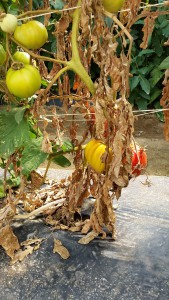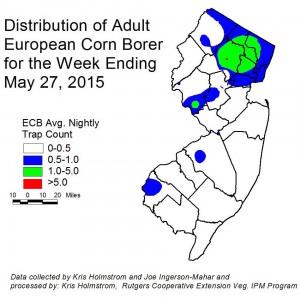Archives for May 2015
White Mold in Greenhouse & High Tunnel Tomato
White mold, or timber rot, caused by the soil-borne fungal pathogen, Sclerotinia sclerotiorum, was found this past week in a high tunnel.
White mold is common and once introduced into a field or high tunnel it can very difficult to control. The pathogen produces black sclerotia on the surface and inside infected stems. Sclerotia, if they make their way back into the soil, can survive for years causing significant problems.
Infected stems will turn a light brown color and dry up becoming brittle. If the main stem is infected the entire plant will collapse looking like a wilt or root rot issue.
Under hot, humid conditions white fungal growth will develop on the surface of the stems and in some cases sclerotia will develop on the outside of the stem. Breaking open the stem will reveal numerous black sclerotia.
All infected plants and or plant material need to be removed from the greenhouse or high tunnel immediately and disposed of properly. Preventative protectant fungicide programs beginning at flowering will help control white mold. Cool, wet weather and poor air circulation favors disease development.
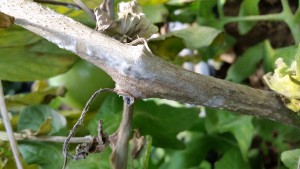
Tomato stem infected by white hold. Note the fungal growth on the surface of the stem.
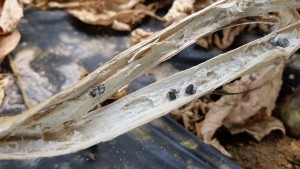
White mold of tomato. Note the black sclerotia developing inside the brittle stems.
Wet Weather and Strawberry Fruit Rots
Wet weather is expected to come in during the first part of the week and linger around for most of it. Now that strawberries are in full production growers need to pay close attention to fruit rots such as anthracnose and botrytis. Overipe or unharvested mature berries left in commercial or u-pick fields can act as sources of inoculum for both pathogens. Importantly, both pathogens can develop and spread rapidly under wet, rainy conditions and the appropriate protectant fungicides need to be applied ahead of any inclement weather.
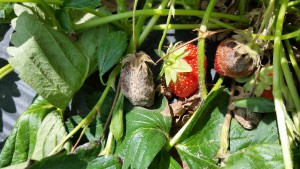
Botrytis, or grey mold, on mature strawberry fruit. Botrytis can develop and spread rapidly under cool, wet conditions.
[Read more…]
Veg IPM Update: Week Ending 5/27/15
Sweet Corn
European corn borer (ECB) adults are being captured with increasing frequency now. Areas of highest activity now include parts of Hunterdon and Morris counties (see ECB map). Within the past 3 days, IPM personnel have found low level ECB infestations in some of the earliest sweet corn plantings. At present, reports of feeding are from Ocean and Somerset counties, however it is likely that feeding is occurring in many early plantings to the south.[Read more…]
Fruit IPM Report 5-26-2015
Peach
Tufted Apple Budmoth (TABM)
Timings for TABM control are outlined below. This is now a minor pest, due to its increased control in recent years. TABM adults started to emerge in northern counties on 5/17. If you are a grower who did have TABM damage last year, you are advised to use the timings that follow:
| Conventional, Diamides |
Conventional, Diamides |
Intrepid, Rimon |
Bt | |
| County Area | AM | EM | EM | EM |
| Southern | About 5/31 | About 6/3 | About 6/2 | 1st 6/6-8 |
| Northern | About 2 weeks away |
